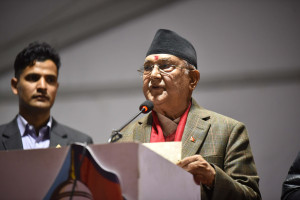Editorial
Thrill kills
One negative impact of adventurism is that it blurs the line between capability and performativity.
On Monday, as Nepalis sat down to scroll their smartphones after a colourful day of Holi, they were confronted by a bone-chilling video. Seventeen youths jumped, one after another, into the Karnali River from the iconic single-pillared bridge in Chisapani, Western Nepal. As each youth made a splash in the water, the onlookers were either hooting or counting them, eagerly waiting to see each of them emerge from the water and sail to the bank. Their wait turned to worry when 30-year-old Mahendra Shahi, one of the 17 youths, failed to emerge from the water. His dead body was later recovered from Sanakatti Ghat in Tikapur Municipality.
The Karnali swimming misadventure was utterly avoidable. While the actual cause of the youth’s death was drowning, the latent cause was a chase for adventurism without a fair self-assessment of his own capability. There seems to have been a lapse in the functioning of the police in the incident, as they should have been better prepared to stop the youths from jumping into the water and rescue them in an emergency. As the days are getting hotter, it is inevitable for youths and children to go swimming. Each year, scores of youths who go out on adventure trips end up killing themselves as they cannot gauge the risks associated with their adventurism.
One negative impact of adventurism is that people increasingly find it hard to distinguish between capability and performativity. In the social media age, where almost every aspect of individuals and their social lives can be live-streamed, adventurism has taken on the role of performativity. In a normative sense, any sport, adventurous or otherwise, is a performative act. However, the popularity that comes with the exaggeration of performativity on social media has made people take disproportionate risks. Those who cannot swim are plunging into the water, those who cannot drive properly are doing stunts, and those who cannot climb hills are going for high-altitude treks just because everyone else seems to be doing so. The result: The thrill they chase ends up killing them.
This risk to lives was one of the reasons the government invoked when it banned the popular social media app TikTok. Of course, there were other reasons for the ban, too, as it had become a site of protest and subversion against the government and established social norms. But the possibility of social media sites like TikTok and Facebook heightening risk-taking behaviour among individuals across the country cannot be ruled out. In 2020, a 24-year-old man from Dang district died after falling off a suspension bridge while making a TikTok video. A year later, another 18-year-old man died in Udayapur after falling off a cliff under similar circumstances. Now that TikTok is gone from Nepal, Instagram’s Reels has become the new platform to post such dubious content.
While the state often puts restrictions on taking such risks, such as issuing a circular against swimming in particular lakes or rivers, there is no way it can follow all individuals and prevent all forms of adventurism. It is incumbent on the individuals to take care of their own lives. But, yes, if a nudge from the state can curtail foolish risk-taking, especially among the youth, it is worth investing a little more in awareness, especially on popular online platforms.




 16.12°C Kathmandu
16.12°C Kathmandu












%20(1).jpg&w=300&height=200)

